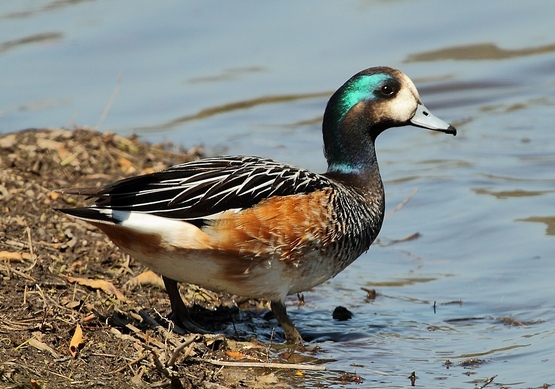
Chiloé wigeon, orSouthern wigeon(Anas sibilatrix)
Phylum —chordata
Class — aves
Order — anseriformes
Family — anatidae
Genus –anas
Appearance
The Chiloé wigeon has a body length of 46 to 56 cm (18 to 22 in) and a wingspan of 75 to 86 cm (30 to 34 in). The wing length is about 25 cm (9.8 in) and the weight is approximately 800 g (28 oz).
This bird has an iridescent green-blue cap on its head, and a bluish gray bill with a black tip. The cheeks and forehead are white, the eyes are dark brown, and there is a white auricular patch. The neck and occipital part of the head are black. The breast is barred black and white and the plumage of the wings is gray and white. The flanks of males are rust colored, and light brown on females. The legs and feet are gray.
Sexual dimorphism is relatively subtle in this species of wigeon. Males are usually somewhat larger and heavier, and with somewhat brighter plumage and more strongly pronounced iridescence of the cap. Apart from these features, it can be difficult to distinguish the two sexes. Juveniles resemble adult birds, but the rust coloring on the flanks is diminished or absent.
Habitat
This duck is indigenous to the southern part of South America, where it is found on freshwater lakes, marshes, shallow lagoons and slow flowing rivers. It breeds primarily in Argentina, Uruguay, and Chile. It migrates to southeastern Brazil for the winter.
Diet
It is an omnivore, feeding predominantly on aquatic plants and grass, and occasionally coastal algae.
Reproduction
This monogamous species breeds between September and December. Pairs inhabit very small breeding territories, building their nests in grasses and under bushes. The female lays eight to ten white or cream-colored eggs. After a gestation period of approximately 24–25 days the ducklings are born. The father helps raise the ducklings; however, he leaves the family after the offspring molt.
In captivity
Lifespan in captivity is up to 30 years.
It is not difficult to keep Chiloé wigeons.In summer, these ducks are kept in outdoor enclosures. The minimum size of the enclosure is 4 square meters: one meter for a bird.
In the cold season, birds are kept in sections of the poultry house. Access to paddocks is open only on warm, windless, sunny days and only during the daytime.
Wild ducks become restless in the fall, when they fly south seasonally, and may join other wild ducks and fly away with them, so you should trim their wings in time or restrict access to walking. You can also cover the paddock with a net.
For winter keeping of ducks any shed (paddock) in which they are protected from wind and precipitation is suitable. The pen for ducks is built in such a way that one duck has at least 1 sq. m. of area with a room of the height of 70-100 cm. Ducks are not afraid of the cold; if they are full, clean and healthy, they can easily live at any frost.
The area of the paddock should not be less than the area of the paddock shed itself. One duck needs a range of 4 sq. m.In this case, all winter it is necessary to maintain a sufficient mirror of the reservoir for birds, not covered with ice. This is achieved in various ways, one of which may be the use of an air compressor. Long hoses from the compressor that pumps air are lowered to the bottom of the reservoir, and air bubbles, rising up, carry warmer water. With constant mixing of warm water from the lower layers of the reservoir with colder water from the surface, the possibility of ice formation is eliminated even in the most severe frosts.
As a winter bedding for waterfowl, you can use soft hay, which is laid out in places where birds rest.
The diet includes grain feed-corn, wheat, barley, millet, oatmeal, wheat bran, grass, meat and fish meal, chalk, small shell, gammarus. In the warm season, it is good to give various greens - cut dandelion leaves, lettuce, plantain, duckweed. Good food for ducks - wet mixture of grated carrots, bran, various cereals. During the reproductive period and during molting, they are mixed with wet food or given separately: fish and minced meat.During working out a diet it should be calculated that the amount of raw protein does not exceed 18%. The optimal proportion of protein food in the food will be 6-8%.
Chiloé wigeonsare friendly to other birds, so they can be kept in the same pond with other ducks.
Artificial shelters for nests are installed in the paddock. Ducks independently incubate, breed and raise ducklings.
 Russian
Russian
 English
English
























